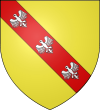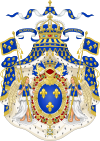- Marguerite of Lorraine
-
- Not to be confused with Margaret of Lorraine.
Marguerite de Lorraine Duchess of Orléans 
Portrait by van Dyck Spouse Gaston, Duke of Orléans Issue Marguerite Louise, Grand Duchess of Tuscany;
Élisabeth Marguerite, Duchess of Guise
Françoise Madeleine, Duchess of Savoy
Jean Gaston, Duke of Valois
Marie Anne, Mademoiselle de ChartresFather Francis II, Duke of Lorraine Mother Christina of Salm Born 22 July 1615
LorraineDied 13 April 1672 (aged 56)
Palais du Luxembourg, Paris, FranceMarguerite of Lorraine (22 July 1615[1] – 13 April 1672) was a duchess of Orléans and Alençon. She was born in Nancy, Lorraine to Francis II, Duke of Lorraine, and Countess Christina of Salm. On 31 January 1632, she married Gaston, Duke of Orléans, son of Henry IV of France and Marie de' Medici. After their re-marriage, Marguerite and Gaston had five children.
Contents
Life
One of six children, she grew up in Nancy which was the capital of her father's duchy. After losing her mother in 1627, she was brought up by her aunt Catherine of Lorraine—the Abbess of Remiremont.
Marriage
While taking refuge from the wrath of the French prime minister, Cardinal Richelieu, Gaston de France, Duke of Orléans, younger brother and heir presumptive of Louis XIII of France, fell in love at first sight with Marguerite.[2] But as France and Lorraine were then enemies, he was refused the king's permission to marry with a sister of its duke, Charles III. Nonetheless Gaston fled again to Lorriane and, in a secret ceremony in the presence of her family at Nancy during the night of 2–3 January 1632, Gaston took the princess Marguerite as his wife.[2] Because he had not obtained the prior permission of his elder brother—one of his many acts of defiance—the couple could not appear at the French court and the marriage was kept secret.
But in November of that year, the Duke of Montmorency, on his way to the scaffold, betrayed his former co-conspirator, Monsieur Gaston, and the king and Richelieu learned of the elopement.[2] The king had his brother's marriage declared null and void by the Parlement of Paris in September 1634 and, despite the Pope's protest, the Assembly of the French clergy in September 1635 on the grounds that a prince du sang, especially the heir to the throne, could only enter matrimony with permission of the king—consistent with French sovereignty and custom.[2] Although Marguerite and Gaston had re-celebrated their marriage before the Archbishop of Malines, a French emissary persuaded the Pope not to publicly protest the matter, and Gaston formally accepted the nullity of his marriage.[2] It was not until Louis XIII was on his death bed in May 1643 that he accepted his brother's plea for forgiveness and authorized his marriage to Marguerite, whereupon the couple undertook nuptials for the third time in July 1643 before the Archbishop of Paris at Meudon, and the Duke and Duchess of Orléans were finally received at court.[2]
By right of her marriage, Marguerite became known as Madame at court. After the death of his mother in 1642, Gaston was bequeathed the Luxembourg Palace, which became the couple's Parisian residence under the name Palais Orléans once they were restored to royal favor. They also sojourned at the Château de Blois, in the Loire Valley, where their first child was born in 1645.
Children
Marguerite and Gaston d'Orléans had five children; three of them survived into adulthood:
- Marguerite Louise d'Orléans (28 July 1645 – 17 September 1721),
- married in Florence on 20 June 1661 Cosimo III de' Medici, Grand Duke of Tuscany (separated 1675);
- Élisabeth Marguerite d'Orléans (26 December 1646 – 17 March 1696),
- married at Saint-Germain-en-Laye on 15 May 1667 Louis Joseph de Lorraine, duc de Guise;
- Françoise Madeleine d'Orléans (13 October 1648 – 14 January 1664),
- married her cousin Duke Charles Emmanuel II of Savoy, on 4 March 1663, no issue;
- Jean Gaston d'Orléans (Paris, 17 August 1650 – Paris, 10 August 1652), duc de Valois.
- Marie Anne d'Orléans (Paris, 9 November 1652 – Blois, 17 August 1656), Mademoiselle de Chartres.
Widowhood
Marguerite's husband, who had played a major part in the Fronde against his nephew the young king Louis XIV (as had her stepdaughter Anne Marie Louise d'Orléans, La Grande Mademoiselle), was exiled to his castle at Blois where he died in 1660. Some time after her husband's death, Louis XIV gave the dukedom of Orléans to his brother (and Gaston's nephew), Philippe de France, Duke of Orléans, who became the new Monsieur. As "Dowager Duchess of Orléans", Marguerite continued to reside in the Palais Orléans where she died on 13 April 1672.
Titles and Styles
- 22 July 1615 – 3 January 1632 Her Highness Princess Marguerite of Lorraine
- 3 January 1632 – 2 February 1660 Her Royal Highness the Duchess of Orléans
- 2 February 1660 – 13 April 1672 Her Royal Highness the Dowager Duchess of Orléans
References
Princesses of Lorraine The generations start from the children of Réné II1st Generation Princess Anne* · Princess Isabelle* · Princess Claude* · Princess Catherine*
2nd Generation Anne, Princess of Orange · Princess Élisabeth3rd Generation Reneta, Duchess of Bavaria · Dorothea, Duchess of Calenberg* · Princess Marguerite · Princess Catherine · Princess Marguerite · Princess Christine · Princess Louise · Marie, Queen of Scotland · Princess Louise · Renée, Abbess of St. Pierre · Antoinette, Abbess of Faremoutier · Louise, Queen of France*4th Generation Christine, Grand Duchess of Tuscany · Antoinette, Duchess of Jülich-Cleves-Berg.* · Princess Anne* · Catherine, Duchess of Nevers · Élisabeth, Electress Palatine · Princess Claude* · Françoise, Duchess of Vendôme · Catherine, Abbess of Remiremont* · Princess Catherine* · Princess Marie* · Princess Christine* · Princess Renée* · Princess Jeanne* · Louise Marguerite, Princess of Conti*5th Generation Nicole, Duchess of Lorraine* · Claude Françoise, Duchess of Lorraine · Henriette, Princess of Lixheim* · Marguerite, Duchess of Orléans* · Princess Christine* · Marie, Duchess of Guise* · Françoise Renée, Abbess of Montmartre*6th Generation Princess Marie Anne* · Princess Anne Eléonore* · Anne Marie Thérèse, Abbess of Remiremont* · Princess Anne Marie* · Princess Catherine Henriette* · Béatrice Hiéronyme, Abbess of Remiremont* · Élisabeth, Princess of Epinoy* · Marie, Princess of Monaco · Charlotte, Mademoiselle d'Armagnac · Marguerite, Duchess of Cadaval · Anne Élisabeth, Princess of Vaudémont · Marie Eléonore, Abbess of Saint Jacques · Marie Françoise, Abbess of Saint Germaine · Suzanne Henriette, Duchess of Mantua · Louise Anne, Princess of Navailles7th Generation Princess Eléonore*8th Generation Élisabeth Charlotte, Abbess of Remiremont* · Princess Louise Christine* · Princess Marie Gabrièle* · Princess Joséphine Gabrièle* · Princess Gabrièle Louise* · Princess Eléonore* · Élisabeth Thérèse, Queen of Sardinia* · Anne Charlotte, Abbess of Remiremont* · Louise Henriette Françoise, Duchess of Bouillon · Élisabeth Sophie, Duchess of Richelieu · Louise, Duchess of Bouillon9th Generation Joséphine, Princess of Carignan · Anne Charlotte, Abbess of Remiremont*- died without issue
Princesses of France by marriage 1st generation None
2nd generation Marie de Bourbon · Princess Marguerite of Lorraine3rd generation 4th generation 5th generation 6th generation None7th generation 8th generation Archduchess Maria Antonia of Austria · Princess Maria Giuseppina of Savoy · Princess Maria Teresa of Savoy9th generation 10th generation Archduchess Maria Theresa of Austria-Este*also a princess of France in her own rightPrincess Blanche of France (1345-1376) · Valentina Visconti (1389-1407) · Isabella of Valois (1407-1409) · Bonne d'Armagnac (1410-1430) · Maria of Cleves (1440-1465) · Princess Jeanne of France (1476-1498) · Catherine de' Medici (1533-1547) · Marie de Bourbon (1626-1627) · Princess Marguerite of Lorraine (1632-1660) · Princess Henrietta of England (1761-1670) · Elizabeth Charlotte of the Palatinate (1672-1701) · Françoise Marie de Bourbon (1701-1732) · Margravine Johanna of Baden-Baden (1724-1728) · Louise Henriette de Bourbon (1752-1759) · Louise Marie Adélaïde de Bourbon (1785-1793) · Princess Maria Amalia of Naples and Sicily (1809-1830) · Duchess Helene of Mecklenburg-Schwerin (1837-1842) · Princess Marie Isabelle of Orléans (1864-1894) · Archduchess Maria Dorothea of Austria (1896-1926) · Gersende de Sabran-Pontèves (1969-present)Categories:- 1615 births
- 1672 deaths
- House of Lorraine
- Duchesses of Orléans
- Duchesses of Alençon
- Burials at the Basilica of St Denis
- House of Orléans
- House of Bourbon
- House of Bourbon (France)
- Princesses of Lorraine
- 17th-century French people
Wikimedia Foundation. 2010.

